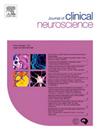脑积水临时化与脑室储液器或经囟门心室穿刺治疗早产儿脑室内出血:一项回顾性队列研究
IF 1.9
4区 医学
Q3 CLINICAL NEUROLOGY
引用次数: 0
摘要
目的早产儿脑室内出血后脑积水(出血后脑室扩张/PHVD)是导致小儿脑积水的最常见原因之一。关于经肾盂脑室抽吸术(TFVT)在这些患者的早期治疗中作为一种临时策略的作用,目前还没有什么证据。本研究旨在比较 TFVT 与使用脑室储液器/接入装置的安全性和有效性。研究方法对前瞻性维护的数据库进行了回顾性审查,包括 2016 年 1 月 1 日至 2022 年 12 月 31 日期间在澳大利亚昆士兰州两大新生儿重症监护病房接受脑室内出血或 PHVD 诊断的所有患者。随访数据来自对全州电子病历的审查。结果筛查了910名患有脑室内出血的低出生体重婴儿的病历。其中,28 名患者接受了心室贮器置入术,36 名患者仅接受了连续 TFVT。死亡率或两年后儿科改良Rankin量表无明显差异。两组患者均未发生有临床意义的颅内出血。脑室储库伤口的 CSF 渗漏更为常见(14% 对 3%,P = 0.02)。结论本研究提供了 III 级证据,表明经海绵体脑室穿刺的安全性和有效性可能与使用脑室贮液器相似。本文章由计算机程序翻译,如有差异,请以英文原文为准。
Hydrocephalus temporisation with ventricular reservoir or trans-fontanelle ventricular taps for intraventricular haemorrhage of prematurity: A retrospective cohort study
Purpose
Hydrocephalus following intraventricular haemorrhage of prematurity (post haemorrhagic ventricular dilation/PHVD) is one of the most common causes of paediatric hydrocephalus. There is little evidence regarding the role of trans-fontanelle ventricular taps (TFVT) as a temporising strategy in the early management of these patients. This study aimed to compare the safety and efficacy of TFVT with the use of a ventricular reservoir/access device.
Methods
A retrospective review of prospectively maintained databases was conducted, including all patients who received a diagnosis of intraventricular haemorrhage or PHVD at the two major neonatal intensive care units in the State of Queensland, Australia between 1st January 2016 to 31st December 2022. Followup data was obtained from review of statewide electronic medical records.
Results
The medical records of 910 low birth-weight infants with intraventricular haemorrhage were screened. Of these, 28 patients underwent placement of a ventricular reservoir and 36 underwent serial TFVT alone.
There were no statistically significant differences in rates of ventriculoperitoneal shunt insertion (83 % vs 75 %, p = 0.41). There were no significant differences in mortality or two year Paediatric modified Rankin Scale. No clinically significant intracranial haemorrhages occurred in either group. CSF leak was more common from the ventricular reservoir wound (14 % vs 3 %, p = 0.02). There was no significant difference in the incidence of CSF infection between the cohorts (6 % vs 4 %, p = 0.71).
Conclusion
This study provides level III evidence to suggest that trans-fontanelle ventricular taps may have a similar safety and efficacy profile to the use of a ventricular reservoir.
求助全文
通过发布文献求助,成功后即可免费获取论文全文。
去求助
来源期刊

Journal of Clinical Neuroscience
医学-临床神经学
CiteScore
4.50
自引率
0.00%
发文量
402
审稿时长
40 days
期刊介绍:
This International journal, Journal of Clinical Neuroscience, publishes articles on clinical neurosurgery and neurology and the related neurosciences such as neuro-pathology, neuro-radiology, neuro-ophthalmology and neuro-physiology.
The journal has a broad International perspective, and emphasises the advances occurring in Asia, the Pacific Rim region, Europe and North America. The Journal acts as a focus for publication of major clinical and laboratory research, as well as publishing solicited manuscripts on specific subjects from experts, case reports and other information of interest to clinicians working in the clinical neurosciences.
 求助内容:
求助内容: 应助结果提醒方式:
应助结果提醒方式:


